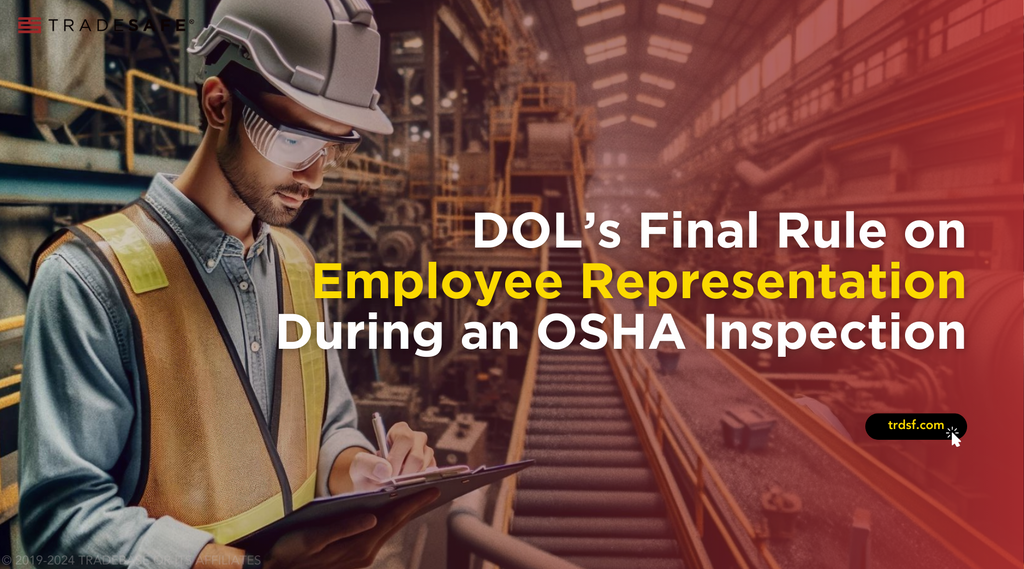
On March 29, a big change happened with workplace safety rules. The U.S. Department of Labor (DOL) announced a new update that's going to make things better for people who want to ensure OSHA compliance safety. This update is all about OSHA inspections. Now, during an OSHA inspection, workers can pick either someone they work with or someone from outside, like union officials, to be there with them. This is a big deal because it means workers have more say in their safety at work.
We're looking at how these changes, especially during an OSHA inspection, can make workplaces safer and better for everyone. This new rule is like a promise from the DOL to look out for workers' safety and health.
Understanding the Final Rule
Let’s dig into this new rule and what it means:
- Choice of Representation: Workers now have the right to choose either a coworker or an outside person to represent them during an OSHA inspection. This means more control and say in their workplace safety and health concerns.
- Criteria for Non-Employee Representatives: Not just anyone can step in; it has to be someone like a union representative who knows the ropes. These representatives are allowed if they have the necessary expertise in spotting workplace dangers and understanding the work environment.
- Historical Context: This update comes after a 2017 court ruling that challenged the old way of doing things. Previously, only company employees could be representatives during OSHA inspections. Now, that’s changed to include more options. It is important to know any approved state occupational safety and health plan to know more about OSHA broad authority during inspection.
The Significance of the Change
- Expertise Matters: The rule acknowledges the importance of specialized knowledge, experience, and language skills in conducting effective inspections. By allowing external experts to participate, the rule ensures that inspections can benefit from a broader range of expertise, potentially leading to safer work environments and less safety and health violations.
- Alignment with OSH Act: This move ensures that OSHA's practices are in harmony with the foundational Occupational Safety and Health Act, fostering more thorough inspections. It's a step towards reinforcing the Act’s intent to provide comprehensive safety oversight in workplaces.
- Fair and Balanced Approach: Echoing the words of Doug Parker, Assistant Secretary for Occupational Safety and Health, the revision reinstates the equitable approach originally intended by Congress. This change represents a return to fairness, ensuring that all parties involved to conduct workplace inspections have a voice.
- Legal Milestone: The amendment stems from a 2017 court ruling, broadening the scope of who can act as a representative during OSHA's workplace inspection. It now includes not just internal employees but also external union representatives and specialists who can accompany OSHA inspectors, reflecting a more inclusive approach to workplace safety.
- Authority’s Endorsement: Doug Parker's statement underscores the critical nature of worker involvement in the inspection process. He highlights how this participation is key to achieving thorough and effective worksite reported safety concerns and ultimately, safer workplaces.
Looking Ahead: Implementation and Adaptation
As we look forward to May 31, 2024, when the OSHA office implements this new rule, it's clear that its impact will stretch far and wide within the OSHA walkaround inspection. This isn’t just about changing how OSHA inspections are done; it's about making workplaces across all industries much safer. The rule's purpose is to enhance the effectiveness of these inspections, ensuring they are thorough and reflective of the real risks workers face every day.
The broader aim here is to elevate safety standards universally. By allowing a wider range of representatives during a physical workplace inspection, we can expect a more detailed and accurate assessment of workplace hazards. This shift promises to create a safer working environment for everyone, demonstrating a strong commitment to the health and safety of workers.
As the rule unfolds, it will shape the future of industrial safety, marking a significant step towards more secure and well-monitored work environments.
FAQs on OSHA Inspection Update
What is one employee right in relation to an OSHA inspection?
An employee has the right to have a representative, such as a coworker or a union representative, accompany the OSHA inspector during the workplace inspection.
What is something you should not do during an OSHA inspection?
You should not interfere with or obstruct the OSHA inspector’s ability to conduct a thorough and effective inspection.
What are the 5 steps of an OSHA onsite inspection?
The five steps are:
- Opening Conference
- Walkaround Inspection
- Employee Interviews
- Record Review
- Closing Conference
What happens when OSHA investigates?
During an OSHA investigation, inspectors assess the workplace for compliance with federal health and safety standards, identify hazards, and evaluate safety protocols, which may lead to recommendations or citations if violations are found.
What right does the employer have regarding an OSHA inspection?
Employers have the right to be present during the inspection, to be informed about the inspection's purpose, and to choose a representative to accompany the inspector
TRADESAFE stands as a pioneering force in industrial safety, offering an array of solutions designed to protect people, places, and equipment across various settings. Our commitment to excellence is reflected in our comprehensive range of products, from Lockout Tagout (LOTO) supplies to workplace signs, all crafted to surpass rigorous safety standards.
